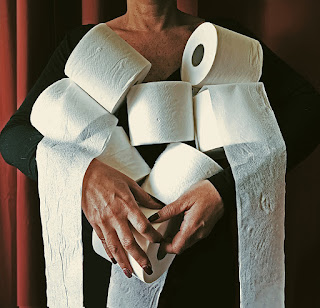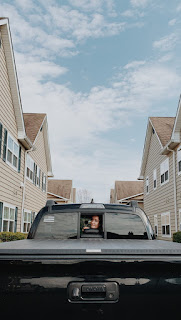Final: Stealing From The Rich Part "A"
Taylor McCormick
Professor Jaime Aelavanthara
Digital Photography I
4 May 2020
Final Project: Sophie Calle
For my final project, I am drawing inspiration from French photographer Sophie Calle. Specifically, one of my sources of inspiration is Calle’s series, titled, The Blind. In this body of work, Calle asks individuals who are blind what their concept of beauty is. She then proceeds to create photographic compositions that accompanied those responses. For example, in one of the works within this series, Calle photographs a patch of grass, and next to this photograph hangs the caption, “Green is beautiful. Every time I like something, I’m told it’s green. Grass is green, trees, leaves, nature too…” In another work from this series, Calle photographs a woman with long, curly hair and captions the photo, “Hair is magnificent. Especially African hair. I curl up in women’s long hair. I pretend I’m a cat and meow.” An important idea to note when observing this series is the vagueness of it. The viewer is not informed that Calle’s sources of responses were people who are blind. The viewer is also not informed about what the question to Calle’s subjects was, and why they were asked this question. This lack of clarity within Calle’s work allows for the photographs to be more open to interpretation. This is extremely intentional on Calle’s behalf, and she has stated herself, “I don’t like to comment on my own work,” since she believes that doing so will limit the viewer’s perception of her art. Personally, I believe that Calle’s intention of this series was to urge her viewers to consider what else is beautiful beyond the preconceived “norms” of beauty. When an individual thinks of beauty, typically one might be referring to the looks of a person, place, or thing. However, this body of work serves as a reminder that the other senses play a role in beauty as well; Smell, taste, sound, and touch also enhance the human experience and can play a role in something being beautiful. Perhaps Calle is urging her audience to not overvalue the sense of sight and to not give into the common notion that this human sense is the most dominant or important one.
In another one of Calle’s series, titled, The Hotel, Calle worked as a hotel maid for three weeks and photographed guests’ rooms. The photographs consist of images of unmade beds, messy rooms, suitcases, filled-closets, and unclean bathrooms. The black-and-white images seem to focus in on a particular object that an individual has clearly had contact with to show the presence of human beings without showing the human beings themselves. Calle incorporates a lot of negative space within her compositions from this series, likely as a means of drawing attention to a focal point, or perhaps to present the idea of something being missing. For example, in one of the photographs of this series, Calle presents a some shoes of different individuals scattered across a carpet floor. In another image from the same series, Calle displays two empty glass bottles sitting on a hotel nightstand. Calle organizes all of these photographs into grids, providing her viewers with multiple glimpses at once into the lives of strangers. My own interpretation of this work is that Calle uses this series as an opportunity to highlight the typical, imperfect aspects of human life in the modern day. I personally believe Calle is using her series to say, “Nobody has a perfectly-made bed every day. Nobody always has a perfectly-organized closet. Life is not always a ‘perfect’ image and nobody is spared from this.” Furthermore, I believe Calle wanted to show the relationship between humans and common objects, and what individuals believe are important enough to travel to a hotel with. When an individual is in their house, they typically have the most access to anything they would want or need. However, in a hotel room, individuals are oftentimes stripped down to their bare essentials and a few “extra” items.
My final project will reflect the ideas that Calle presents in both of these series. Similar to Calle’s The Blind series, my body of work will be focusing on the lives of individuals with disabilities. From a previous project I worked on, in which I was required to record interviews I conducted with individuals who live with disabilities or work with children who have disabilities, I will use some of their responses as inspiration for the photographs I create. As for the style that I will be presenting these photographs in, I will be using Calle’s black-and-white still-life photography in her The Hotel series as inspiration. Similar to this series, my photographs will consist of objects that are representative of individuals and the lives that they live. These photographs will reflect the responses that I was provided with in interviews concerning their life experiences regarding disabilities. I will be utilizing negative space in a similar fashion to Calle in her The Hotel series. My goal for this work is for my viewers to be curious about the lives of individuals with disabilities. Through creating this work, viewers will receive a glimpse of how the lives of people with disabilities look different than the lives of “typical” people. In addition, I hope to remind my viewers that individuals with disabilities can still do anything they want, they just might have to do it in their own unique way.
Works Cited
Insights of 'Blind' in Eye of the Beholder : Art: Sophie Calle lets those without sight speak of
beauty and lets the resulting exhibition speak for itself. (1995, October 20). Retrieved from https://www.latimes.com/archives/la-xpm-1995-10-20-ca-59024-story.html
Schilling, M. K. (2017, April 10). The Fertile Mind of Sophie Calle. Retrieved from
https://www.nytimes.com/2017/04/10/t-magazine/sophie-calle-artist-cat-pregnant.html
Tate. (1981, January 1). 'The Hotel, Room 47', Sophie Calle, 1981. Retrieved from



Comments
Post a Comment